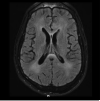HIV-associated neurocognitive disorder
- PMID: 24156898
- PMCID: PMC4108270
- DOI: 10.1016/S1473-3099(13)70269-X
HIV-associated neurocognitive disorder
Abstract
Neurological involvement in HIV is often associated with cognitive impairment. Although severe and progressive neurocognitive impairment has become rare in HIV clinics in the era of potent antiretroviral therapy, most patients with HIV worldwide have poor outcomes on formal neurocognitive tests. In this Review, we describe the manifestations of HIV-associated neurocognitive disorder in the era of effective HIV therapy, outline diagnosis and treatment recommendations, and explore the research questions that remain. Although comorbid disorders, such as hepatitis C infection or epilepsy, might cause some impairment, their prevalence is insufficient to explain the frequency with which it is encountered. HIV disease markers, such as viral load and CD4 cell counts, are not strongly associated with ongoing impairment on treatment, whereas cardiovascular disease markers and inflammatory markers are. New cerebrospinal fluid and neuroimaging biomarkers are needed to detect and follow impairment. Ongoing research efforts to optimise HIV therapy within the CNS, and potentially to intervene in downstream mechanisms of neurotoxicity, remain important avenues for future investigation. Ultimately, the full control of virus in the brain is a necessary step in the goal of HIV eradication.
Copyright © 2013 Elsevier Ltd. All rights reserved.
Figures

References
-
- Tan IL, McArthur JC. HIV-associated neurological disorders: a guide to pharmacotherapy. CNS Drugs. 2012;26(2):123–34. - PubMed
-
- Harrison TB, Smith B. Neuromuscular manifestations of HIV/AIDS. J Clin Neuromuscul Dis. 2011;13(2):68–84. - PubMed
-
- McArthur JC, Steiner J, Sacktor N, Nath A. Human immunodeficiency virus-associated neurocognitive disorders mind the gap. AnnNeurol. 2010;67:699–714. - PubMed
-
- Schouten J, Cinque P, Gisslen M, Reiss P, Portegies P. HIV-1 infection and cognitive impairment in the cART era: a review (editorial). AIDS. 2011;25(5):561–75. - PubMed
Publication types
MeSH terms
Grants and funding
- K23MH081786/MH/NIMH NIH HHS/United States
- AI069495/AI/NIAID NIH HHS/United States
- R01 NR014449/NR/NINR NIH HHS/United States
- R01NRO012657/PHS HHS/United States
- NS077384/NS/NINDS NIH HHS/United States
- R01NR014449/NR/NINR NIH HHS/United States
- U10 NS077384/NS/NINDS NIH HHS/United States
- UM1 AI069495/AI/NIAID NIH HHS/United States
- M01 RR000036/RR/NCRR NIH HHS/United States
- R01NR012907/NR/NINR NIH HHS/United States
- 22005/PHS HHS/United States
- R01 NR012907/NR/NINR NIH HHS/United States
- K23 MH081786/MH/NIMH NIH HHS/United States
- R01 NR012657/NR/NINR NIH HHS/United States
- U01 AI069495/AI/NIAID NIH HHS/United States
LinkOut - more resources
Full Text Sources
Other Literature Sources
Medical
Research Materials

